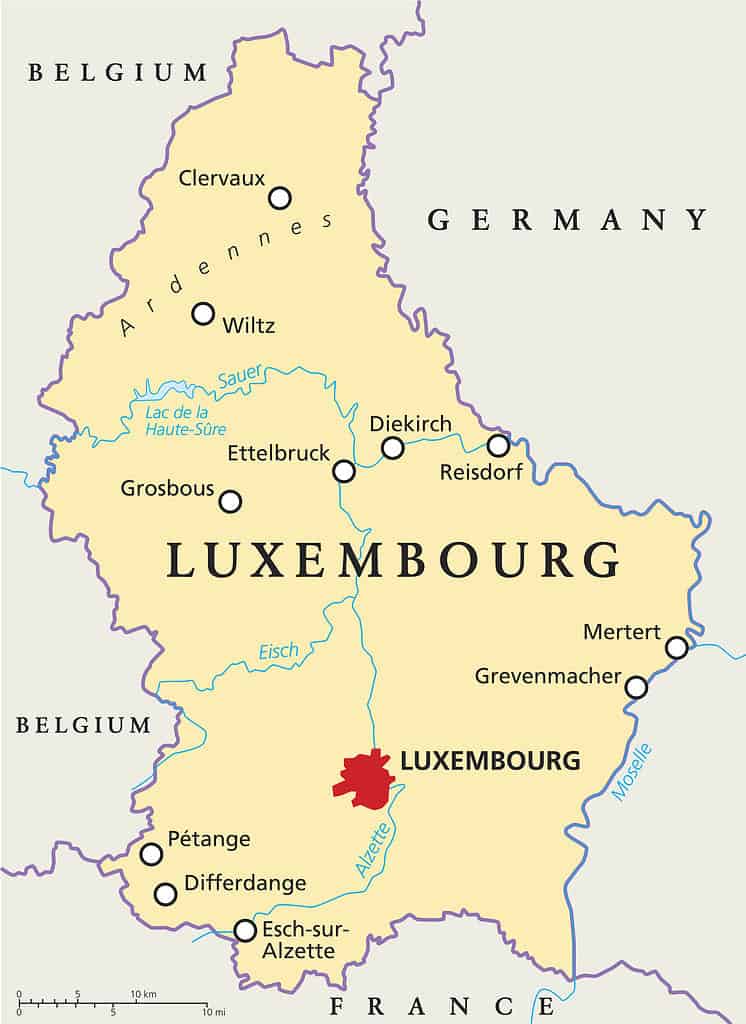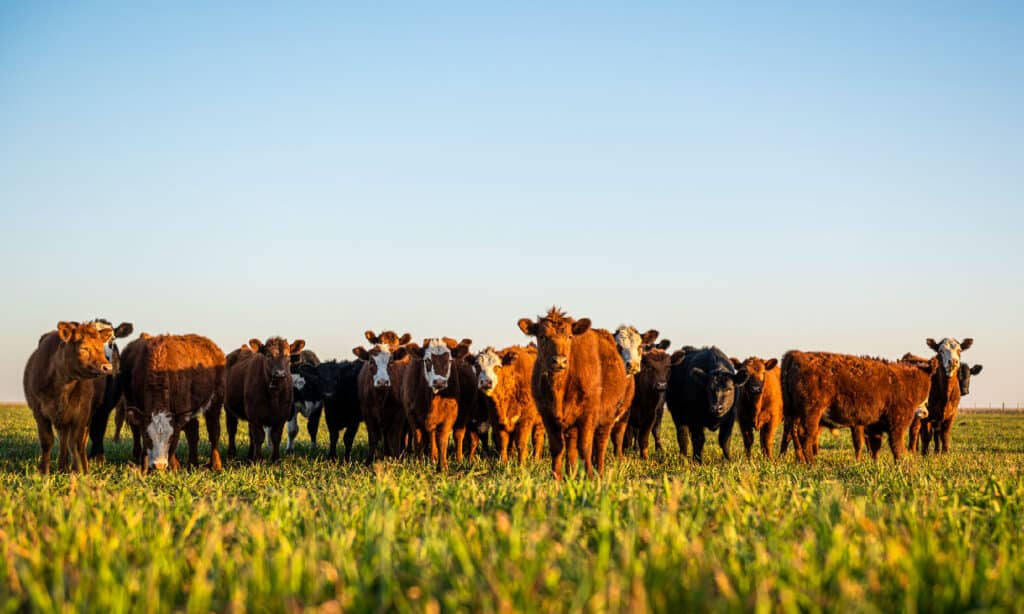Everything is bigger in Texas: from food portions to homes, the Lone Star State has cultivated a reputation for going big whenever there’s growth to grab. One such facet is ranches. Texas has many ranches across its state, but one covers so much land, it’s bigger than the entire state of Rhode Island.
King Ranch stands as one of the largest ranches in Texas — and in the world. The ranch encompasses hundreds of thousands of acres, thousands of cattle, hundreds of horses, and a whole lot of help to keep the business running. Located in Kingsville, the ranch and the town have histories that closely coincide with each other.
Discover just how big King Ranch is, from miles and acres to kilometers and hectares. Explore how big the ranch is compared to other famous landmarks as well.
The Legacy of King Ranch

Luxembourg is smaller than Texas’s largest ranch.
©iStock.com/PeterHermesFurian
King Ranch is huge — so big, it’s larger than the country of Luxembourg in Europe and the state of Rhode Island on the East Coast (as mentioned above).
Located between Corpus Christi and Brownsville, King Ranch doesn’t actually have a contiguous plot of land. Instead, it has four large divisions — Santa Gertrudis, The Laureles, the Encino, and the Norias — that span six counties, including:
- Kleberg county.
- Kenedy county.
- Brooks county.
- Jim Wells county.
- Nueces county.
- Willacy county.
First purchased in 1853, King Ranch has grown exponentially in both size and services. Captain Richard King first purchased a small plot of land over 160 years ago to breed cattle and create a life for himself. Along with his friend Gideon K. Lewis, King decided to make the plot of land a ranch after a grueling four-day horseback trip brought him to Santa Gertrudis Creek. The shade from the nearby mesquite trees and the stream, the first he’d seen during his ride through the Wild Horse Desert, impressed him so much he vowed to create a working cattle ranch on the fruitful land.
After establishing a cow camp and growing the ranch, King realized a need for ranch hands.
When he originally traveled to Cruillas, Tamaulipas, Mexico in 1854, he purchased the village’s entire cattle population. Shortly after leaving, King realized that his purchase only solved the short-term problem of providing income to survive the ongoing drought in the area. Unknowingly, he’d created a long-term issue: removing its source of future income. So, he returned to the town and offered food, shelter, and income to the villagers if they agreed to work for him. As the ranch grew, these workers became known as “King’s men.”
Measuring King Ranch: Miles and Acres
Traditionally, ranches are measured in miles and acres. By these estimations, King Ranch is 825,000 acres large. Measured in miles, King Ranch is 1,289 square miles large.
In comparison, other big Texas cities take up roughly a third of the square mileage that King Ranch encompasses. King Ranch’s 1,200+ square miles dwarfs the square mileage of major cities like Houston, at 599.59 square miles, and San Antonio, at 460.93 square miles.
Acres and square miles have been used by both American and English agencies as a unit of measurement for land.
King Ranch in the Metric System: Kilometers and Hectares
While America uses acres and miles for most — if not all — land measuring, most of the rest of the world chooses to use the metric system with kilometers and hectares. Measured with these units, King Ranch is:
- 3,340 square kilometers large.
- 334,000 hectares large.
When it comes to units of measurement, the United States is among the only countries left that largely use the Imperial system. Liberia and Myanmar use the Imperial and Metric systems interchangeably but have moved recently to only the Metric system.
Compared to Other Famous Landmarks
Compared to other landmarks, King Ranch still reigns as one of the largest totals of owned land in the world. In Texas, every other ranch pales in comparison. For example, you could fit the Kokernot 06 Ranch, The Four Sixes Ranch, and the Jones Family Ranch inside Kings Ranch and still have 7,000 acres left over. While you wouldn’t be able to fit the second-largest ranch in Texas in King Ranch twice, you’d come pretty close at 1.6 times.
For another view of King Ranch’s expansive reach, consider how many of each world-renown landmark you could fit inside the ranch:
- Sydney Opera House: 185,555 opera houses.
- The Colosseum: 137,500 Colosseums.
- Pyramids of Giza: 63,018 sets of pyramids.
- Taj Mahal: 19,647 Taj Mahals.
- Machu Picchu: 10 Machu Picchus.
Exploring the Boundaries: Touring the Ranch
King Ranch offers many different tour options based on visitors’ intent for coming to the ranch. There are daily ranch tours, special interest tours, nature tours, and motor coach tours offered throughout the year.
The daily ranch tour lasts about an hour and a half, accommodating both public walk-ins and reservation guests. Starting at Santa Gertrudis Creek — the same pace the dream for King Ranch started — visitors will learn the history steeped in the stables, pastures, and hay of the ranch.
Conversely, special interest tours are booked by reservation only to ensure a guide can tailor-make the event to your liking. These may focus on cattle and horse operations, mill operations, or a deeper dive into the history of the ranch.
King Ranch celebrated over 25 years of nature tours on its campus during its 2022 and 2023 seasons. With so many different ecosystems, guides are never at a loss to show their tour groups the incredibly diverse landscapes on King Ranch’s property. Guests will most likely see birds, deer, and a range of fauna on their nature tour.
Finally, the ranch does offer large-scale tours for motor coach companies. However, tours have a minimum of 25 individuals and the company must provide its own transportation rather than relying on King Ranch. These group tours can cover anything the previously-mentioned tours covered in addition to the King Ranch Cowboy Camphouse Barbeque.
The Diverse Ecosystems of King Ranch

King Ranch functions primarily as a cattle ranch.
©iStock.com/nickalbi
While the ranch functions as both a cattle and horse ranch, the vast ecosystems around it flourish with wildlife. The decision to cultivate the ranch’s many ecosystems reaches back into the 1940s when King Ranch hired Val W. Lehmann. This allegedly made King Ranch the first privately-owned ranch to add a professional wildlife biologist to its full-time staff.
With his arrival, the ecosystems on the ranch had a staunch supporter and protector. Lehmann created census techniques that monitored wildlife populations — a system that remains in use in some capacity today.
Significant scientific research about wildlife takes place on King Ranch today. Its Wildlife Department conducts surveys and research projects to better understand and manage hundreds of thousands of acres of natural resources.
Finally, King Ranch boasts an incredibly varied list of birds to watch within its environment. Birdwatchers have the chance to view over 370 species from touring the ranch. The foremost avian authority, the American Bird Conservancy, has named the ranch as a Globally Important Bird Area. Some of the “South Texas specialty birds” include winged creatures like:
- The ferruginous pygmy-owl.
- The tropical parula.
- The northern beardless-tyrannulet.
- The Audubon’s oriole.
- The Botteri’s sparrow.
- The white-tailed hawk.
A plethora of these birds stay throughout the year, but some migrate seasonally — bringing new neighbors to the block as seasons change.
The Ranch’s Economic Impact in Texas and the Nation
As the town of Kingsville was created in tandem with King Ranch, it’s no wonder the ranch continues to have significant economic contributions to the local and regional economies of South Texas.
King Ranch played a large part in getting railroads, packinghouses, and harbor improvements in Kingsville and nearby Corpus Christi to trade and sell cattle. Throughout the end of the 1800s and into the early twentieth century, King Ranch had a large hand in agricultural development, land sales, and town-building projects.
Today, King Ranch continues to produce goods within the agribusiness market: cattle, cotton, grain, sugar cane, and luxury retail goods.
Sustainability and Future Challenges

Windmills help power the ranch and contribute to its sustainability initiatives.
©Stockr/Shutterstock.com
With so much land under its belt, King Ranch holds its stewardship of the ecosystem it inhabits in high regard. From the outset of the ranch, efforts have been made to preserve the environment and find innovative ways in which it can flourish. Specifically, the management of renewable resources balanced with creating a productive space for livestock, wildlife, and fauna, remains the priority of King Ranch’s sustainability efforts. Some of the improvements made to the ranch include:
- Windmills at two-mile intervals across all four divisions.
- Earthen tanks at windmill sites provide overflow water to wildlife.
- Cutting shrubs to provide shelter for quail.
- “Living fences” in open areas to increase wildlife security cover.
In addition to the ranch’s own efforts, it established The King Ranch® Institute for Ranch Management, which educates ranchers across the nation on how to use a systems approach to ranch management that innovates and promotes sustainability. This program, held in tandem with Texas A&M University-Kingsville, is the only Masters of Science in Ranch Management program in the world.
Highlight any environmental challenges the ranch may face in the future.
Furthermore, the ranch remains a host of the Caesar Kleberg Wildlife Research Institute: an initiative dedicated to protecting threatened wild game in South Texas. In the earliest years of the twentieth century, Caesar Kleberg initiated the first wildlife habitat enhancement and management programs on King Ranch from his home on the Norias Division. Since then, researchers, educators, and students study at this comprehensive wildlife research institute to continue keeping the fauna of the nation safe from unregulated hunting laws.
King Ranch’s Legacy Continues
As the largest ranch in the United States and one of the largest ranches in the world, King Ranch includes some out-of-the-world measurements. King Ranch remains a staple in Southern Texas ranching, even going so far as to deem itself the Birthplace of American Ranching.
Unable to flourish without the help of hundreds of ranch hands in its earliest years, the 825,000-acre ranch now enjoys the job of playing a large role in breeding cattle, Quarter Horses, and champion Thoroughbreds — as well as continuing to contribute to national agribusiness success.
The photo featured at the top of this post is © Zack Frank/Shutterstock.com
Thank you for reading! Have some feedback for us? Contact the AZ Animals editorial team.






